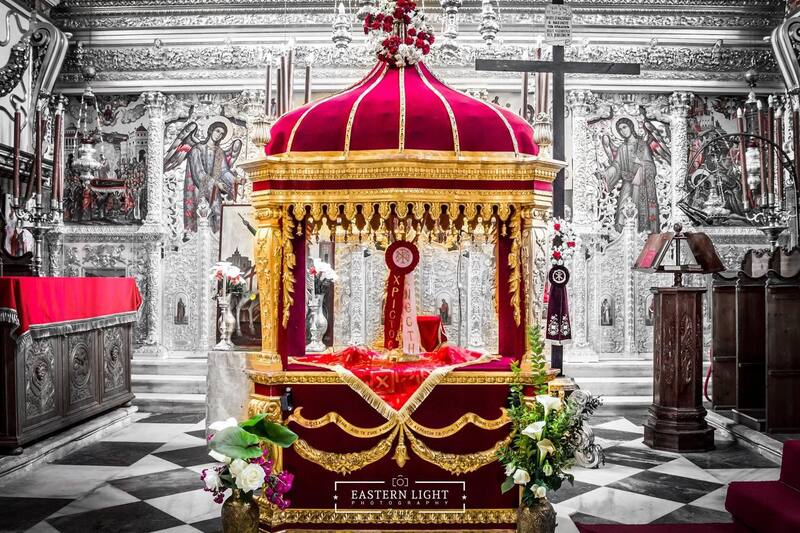On the Saturday of Lazarus, marking the beginning of Megalovdomado
Zakynthos Guide
Our Guide
During Holy Week, Zakynthos takes on a hue all its own
10/04/2023
The Zakynthian Easter is one of the best in Greece

Zakynthos becomes a whole new shade of red during Holy Week. The locals here also have a very high regard for the propriety of their long-established religious rites and other cultural practices.
At eleven o'clock on the Saturday of Lazarus, the somber church bells of our island's cities and towns began to ring out Megalovdomado. On this feast, the inhabitants of Zakynthos weave crosses, "vagiophores," suns, horses, and other symbols out of the vibrant yellow palm tree leaves rather than the usual laurel that is distributed across Greece. The "nontsoli" (young men of the First Church) carry vagi to each home after the Divine Liturgy on Sunday of Vai, which takes place in one of our churches decorated with vai. The faithful then place them on their icons with the blessing of the Priest-Vicar. Upon completion of the Liturgy, our places of worship are turned into somber shrines of mourning.
Cultural traditions in your homeland could lead you astray if you believe the crucifixion of Jesus Christ would take place after the fifth gospel. Following the eleventh Gospel in our canon comes The Crucified. As the cantor sings "Today he hangs on a tree..." with the Crucifixion lighted, the Zakynthian tradition states that the procession commences. The next step is to have the chorus or soloists (exclusive to Zakynthos) sing the famous Psalm "Ina ti efryakan etni...", which sets a powerful tone. Reciting "The day after," the twelfth gospel, in "Zakynthina," is the highlight of the Maundy Thursday service.
Our island has entered a terrible hyperdrive on this Good Friday. At Zakynthos, both reason and the inherent essence of horses play roles in the Divine Drama. During the morning after the Procession of the Great Hours, the Apostilles "Ote ek tou tou houlos Se nekron..." are sung, coinciding with deposition in Zakynthos. Christos would be slung over the shoulder of the priest as he emerged from the Sacred Altar. In contrast to the typical embroidered epitaph seen across Greece, a two-sided wood-carved image of the crucified Christ called a "Lamb" is used.
Another unique aspect of Zakynthos is the epitaph, which is the place where the body of Christ is deposited after the procession. Inscriptions on these tombstones are really artistic creations, with their intricate carvings in wood and embellishments of velvet and gold leaf.
Final Resting Place Noon is the hour of Good Friday. Four o'clock. The most well-known landmark of Zakynthos is Megalobdomados. Tourists and locals alike go to Molos' Holy Church of Agios Nikolaos to hear the Lord's prayer litany. It exudes a distinct atmosphere. Emotions permeate the hearts of every Zakynthian. When the philharmonic plays "Ina ti efryakan etni...", it starts the litany of sadness. The iconic image of the Crucified Christ shows the Virgin of the Passion, who is also called the "Mater Dolorosa" or the "Mother of Sorrows." As the litany makes its way across the city, it eventually returns to Solomos Square, where the Metropolitan, seated on a pedestal, blesses the faithful and clergy with the Crucified. At the end of the litany, the epitaph says that Christ's corpse is in the temple.
At about 4 in the morning, thousands of people come to see the unveiling of the Epitaphion. Epitaphios goes back to the temple at 5:30, and the miraculous Mass goes on from there. The residents of Zakynthos joyfully chant the song "Praise the Lord...", which is accompanied by the world-renowned "Gloria" or the "piece" (First Resurrection). Witnessing the housewives of every home smashing their clay jars during the First Resurrection will take your breath away.
A Mass is held in the Metropolitan Cathedral at 11:15 p.m. on Great Saturday night. The Zakynthos Resurrection procession begins its journey to St. Mark's Square around 11:45 in the morning. As the characteristic Zakynthian church music accompanies the words of the Metropolitan, "Christ is Risen" declares the Resurrection of Christ to the throngs of Christians that have gathered in the plaza and the surrounding environs. Next, we find ourselves at the Metropolitan Cathedral, site of the events of "Arate Pylas...", where the Icon of the Resurrection has recently returned. Everyone in the city and the neighboring villages is expected to attend the Resurrection Divine Liturgy on Easter morning, according to local custom. When the reading of the Gospel is finished, the church bells are supposed to ring out as a matter of "andeti" (custom). Two Resurrection Divine Liturgies are celebrated exclusively in the church of our Patron Saint Dionysios. Easter Sunday at one o'clock in the morning for both. On Easter Sunday afternoon, the city's Holy Church of Agios Lazarus hosts Vespers of Love, a procession of the Resurrection icon and the magnificent Panagia Galanousa icon, and other religious ceremonies.
Make a weekend out of it by visiting some of the world's most beautiful churches and participating in daily liturgies and litanies honoring the Virgin Mary and the Resurrection. As part of our city's annual afternoon procession, the Virgin of Laurentina's picture makes her way from Psiloma (Bochali) to the Holy Church of the Holy Trinity.


